The future of supply chain management will be increasingly data-enabled and complex
Supply chain management is a lot to handle, and with continuous changes and disruptions troubling the market, things are only getting more complex. This blog post takes a look at the benefits that data and artificial intelligence can bring to supply chain management, and what are the most viable ways to get started.
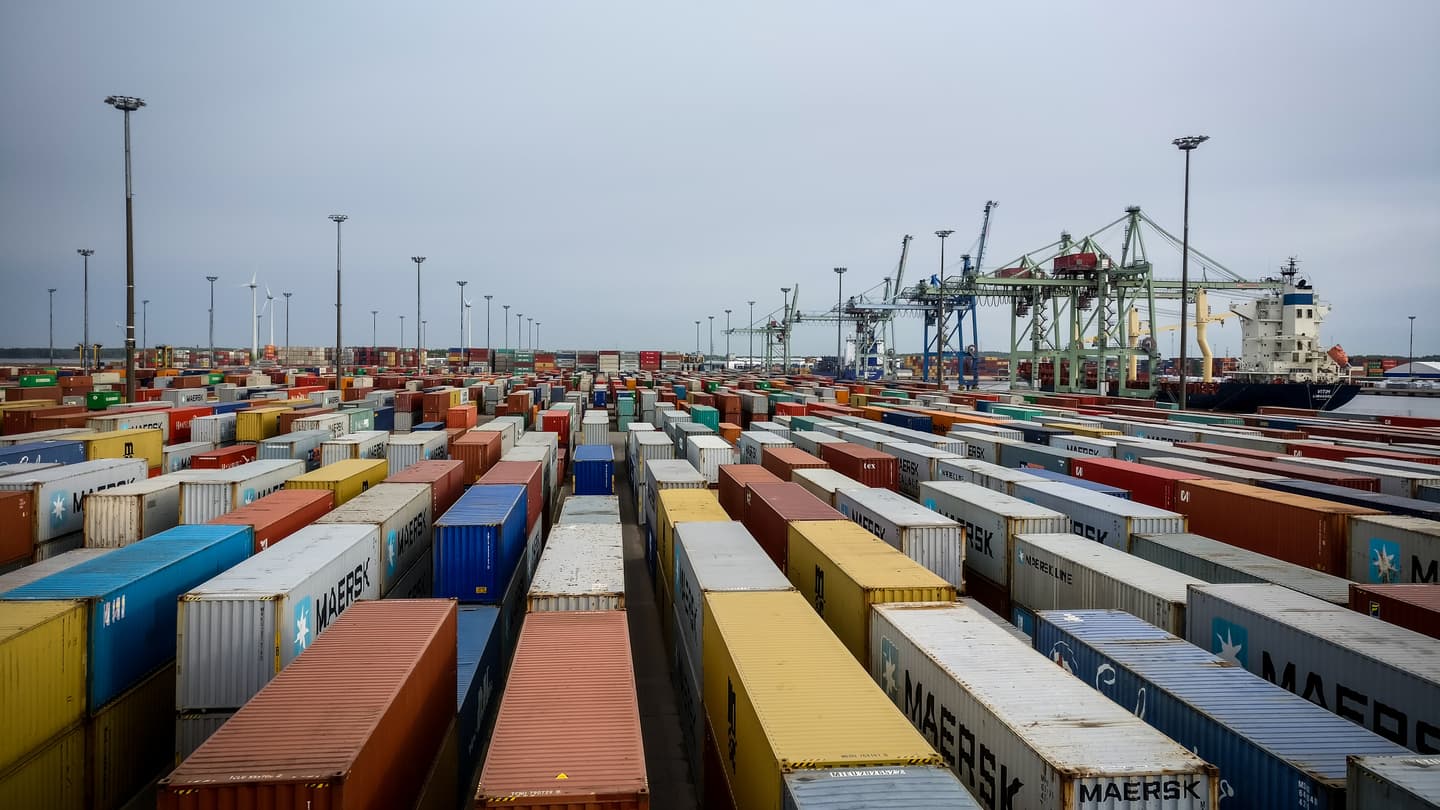
AI in Supply Chain Management
Uncertainty in the market can cause significant unexpected changes throughout the value network, from sourcing to logistics, and from production to sales. This will almost inevitably lead to growing numbers of partners and, consequently, even more complicated supply chain management. Many companies have turned to harnessing data and artificial intelligence to gain a competitive edge and position themselves to better react to – and proactively plan for – a changing environment.
McKinsey surveys suggest that supply chain management is one of the leading investment targets in many companies. In The State of AI in 2021, 11% of the respondents indicated that they have recently invested in AI solution development in supply chain management:
“While AI’s revenue benefits have held steady or even decreased since the previous survey – especially for supply chain management, where AI was unlikely to compensate for the pandemic era’s global supply chain challenges – the opposite is true of costs. Respondents report significantly greater cost savings from AI than they did previously in every function, with the biggest year-over-year changes in the shares reporting cost takeout from using AI in product and service development, marketing and sales, and strategy and corporate finance.”
The reasoning for these investments seems quite clear: over 50% of the respondents in the same survey have noted significant (higher than 20%) cost reductions attributed to AI and data.
The 2021 survey also notes that use cases for AI in supply chain management are increasing. Leading use cases paint a clear picture centered around value network optimization, emphasizing the holistic nature and role of supply chains with the company's entire value stream. McKinsey’s analysis identified two leading supply chain management use cases – optimization of the logistics network, and sales and demand forecasting.
The current state of AI & data use in supply chain management
The traditional view of supply chain management largely focused on optimizing the unidirectional flow of materials and services, and with a more limited amount of information, the flow backward. Information over multiple steps is often transmitted as a static snapshot that moves together with long planning cycles – ranging from 36 months on the strategic level to annual 12-month planning and six-month tactical planning. The slow flow of information often stems from limitations in processes, data and reporting.
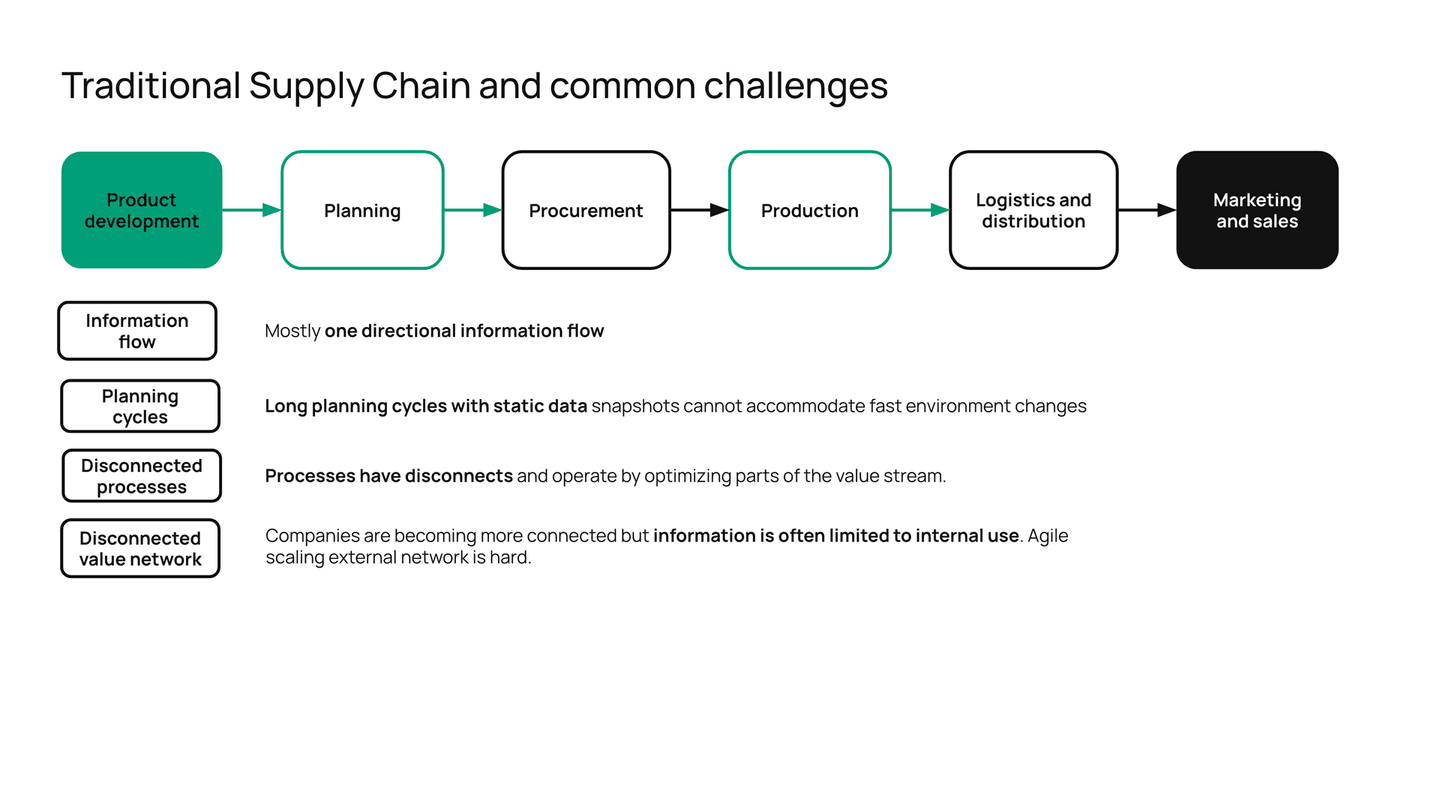
Toward value networks and connected companies
Compared to the current state, the most important benefit that more modern data and information architecture trends have to offer is to enable near real-time multidirectional information flow between different functions and processes.
When it comes to data flow and use of data and AI in supply chain management, this is a revolutionary shift, and it is focused around these themes:
- Composable business architecture
- Data mesh and fabric with data APIs
- Event-driven data architectures
- Predictive analytics
- Digital twin capabilities with the possibility to simulate on a company/process level
Typical steps for transforming supply chain management with data and analytics
The enthusiasm and excitement we see today revolves largely around digital twins. Perhaps the most hyped aspect is the ability to not just visualize complex systems – but also simulate and create scenarios, continuously improve operations and better adapt to changing internal and external circumstances. The goal is excellent – but the reality is that companies are often not yet mature enough in their data and analytics journey to jump straight into fully modeled digital twins.
Based on the work we’ve done together with our clients, we can outline three typical steps for growing data maturity both within supply chain management and beyond:
- Creating an understanding of business functions with data visualization
- Developing value stream visualizations and point solutions using data and machine learning
- Creating more systemic change with a data and machine learning solution portfolio with the capability to simulate, visualize and pass data across multiple value streams
Currently, the focus is usually on establishing data enablers like data platforms and data catalogs, and on working on early productionized point solutions. Some companies are already moving towards a machine learning solution portfolio that covers multiple parts of their value streams. At least for now, we seldom see full digital twins with significant simulation capabilities.
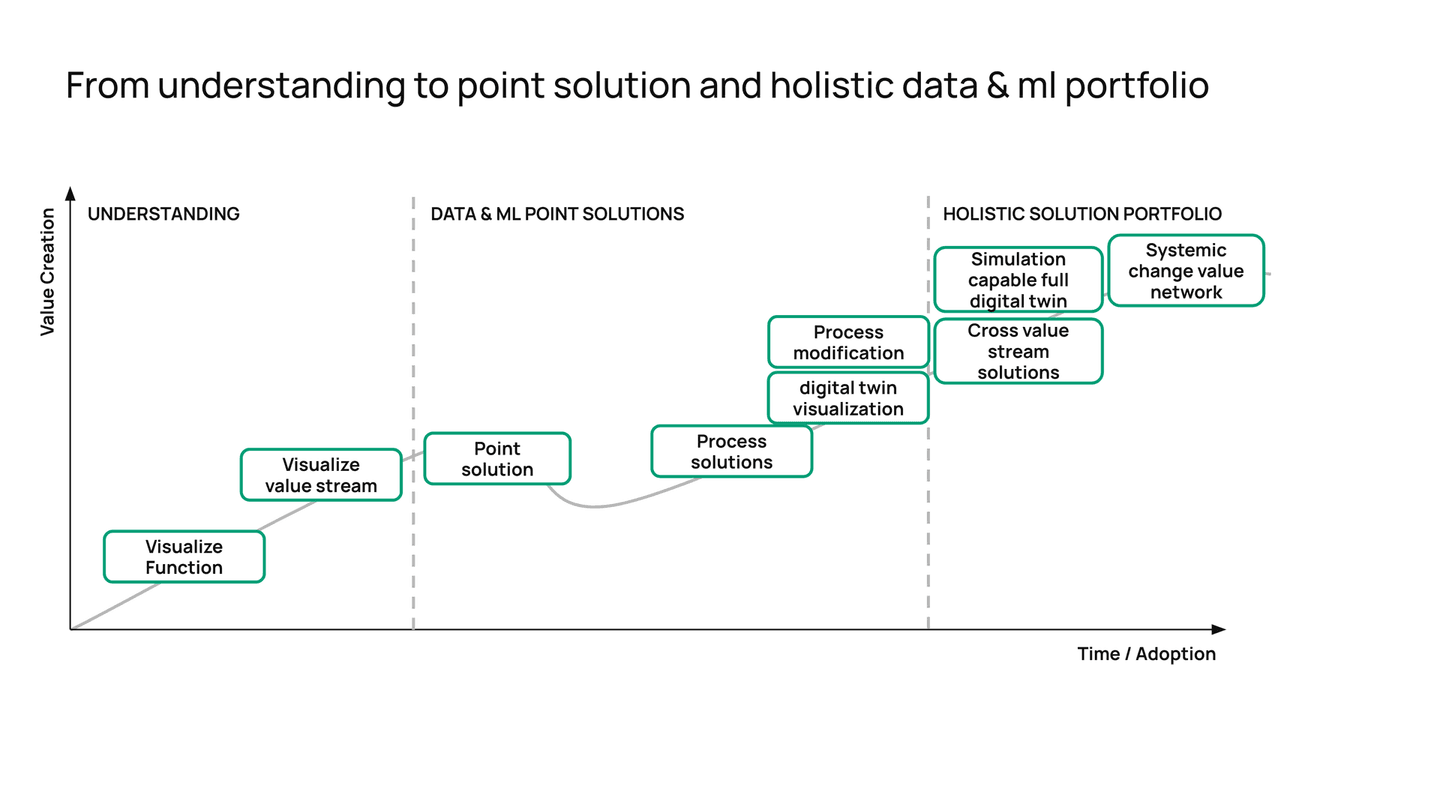
Most common ways to augment supply chain management with data and analytics today
When introducing data and AI capabilities, approaches typically go through quite similar steps starting from visualization and sharing real-time data between functions, then creating point solutions, and finally, moving towards a solution portfolio that spans multiple value streams.
This may sound a bit abstract – so what could these point solutions actually be? Many public references and examples have to do with establishing data flow between processes and functions, as well as creating new information with machine learning models. To help make things more concrete, let’s go through some point solution examples that involve data and machine learning:
Demand sensing and demand forecasting are common solutions that support planning and procurement. The main benefits of introducing these forecasts to earlier stages of the value chain are quite straightforward – with improved demand forecasting, companies can better plan their production and sourcing activities, which in turn allows for faster and more accurate planning cycles. These forecasting models also grant more flexibility in scenario building with the possibility to create scenarios for different raw materials and production cycles.
Dynamic routing and freight contracting are also reasonably common and will be increasing in importance in the future. As sustainability targets grow and freight and logistics costs rise, companies have to put more time and effort into carefully planning and optimizing their logistics-related activities.
Production planning and optimization often goes hand in hand with demand forecasting, but for many companies, this is more focused on creating production digital twins for factories with increasing IoT and data capabilities. Many companies have already introduced some machine learning on edge devices to better optimize their production flows and improve quality assurance practices. Increased understanding of raw material pricing and the possibility to quickly modify production cycles in conjunction with demand forecasting will help companies make production more agile in a changing environment as well as base their decisions on higher quality information, all the way from sourcing to sales.
Warehouse automation and inventory optimization have been transformed in recent years with the growth of robotics, machine learning and data. Better visibility into demand forecast, production, and logistics capacity has enabled companies to significantly improve their cycle and safety stocks. Improved raw material and finished goods inventories, on the other hand, have helped improve sustainability and working capital management with less money tied up in inventory. Warehouse and inventory operations are some of the biggest beneficiaries of improved data and information flows between functions linked with production, logistics, and sales.
Data-enabled rapid product development and prototyping – machine learning has introduced faster ways for rapid configurations and production testing, both of which have previously required a lot of manual work. With the help of machine learning, companies have been able to test millions of product variations and generate production configurations and packaging requirements all the way to logistics and demand forecasting without creating a single physical product.
One important point to note is that many companies are actually creating multiple data sharing solutions and visualizations of digital twins in different parts of their supply chain, but lack a full picture across multiple functions within their business – let alone having the capability to visualize full supply chain management value streams or simulate the impacts of decisions.
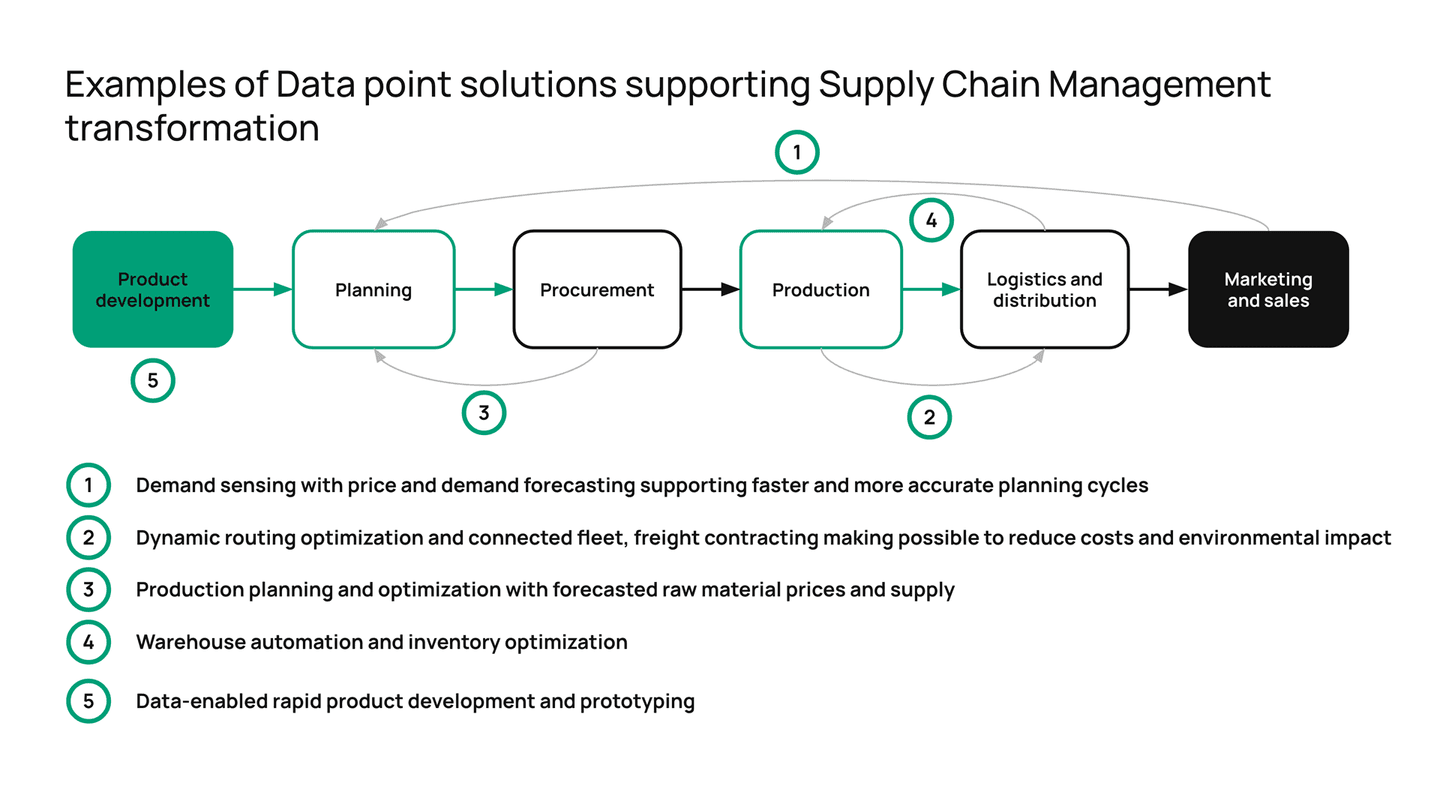
The future of supply chain management – complete with full digital twins
We’ve now discussed the current state, but what might the future of supply chain management look like with the introduction of connected companies, composable business architectures, data and AI?
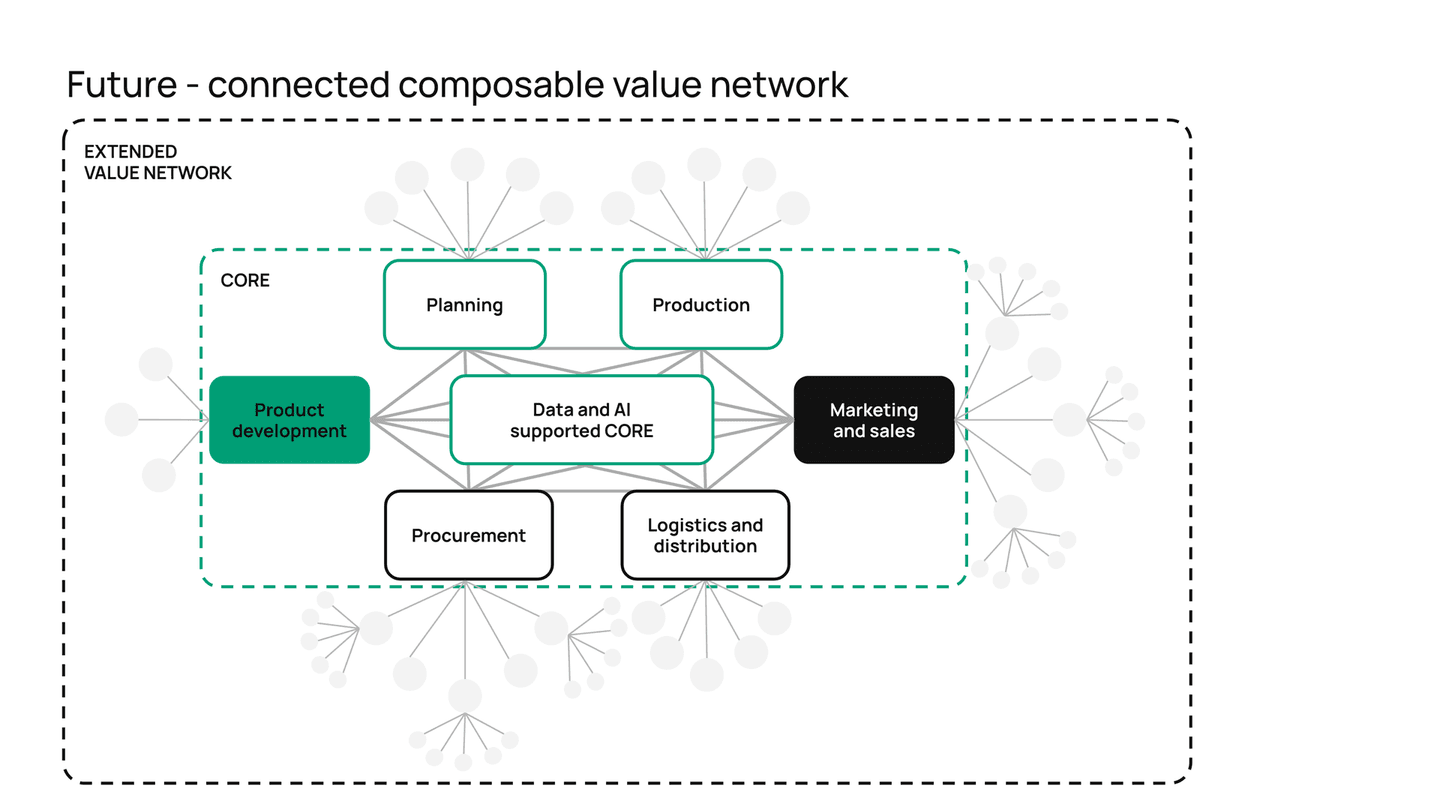
In the future, supply chain management will be interconnected with other functions within the company as well as with external partners, and consequently, rely more heavily on information and data from both internal and external sources. Supply chain management will also involve more artificial intelligence, both in material and logistics flow and in information flow.
A bit further down the road, digital twins with simulation capabilities and scenario building will also become more common in supply chain management. Especially in manufacturing, their primary focus will be on shortening planning cycles and paving the way towards more real-time planning.
Some of the biggest topics in using data and AI in supply chain management will be:
- improving information flow and planning cycles
- connecting information from multiple value streams and processes
- creating connected value networks, and
- creating simulation-capable digital twins
- establishing a more proactive supply chain management flow
Futurice References
We worked side by side with Fira’s skilled teams to get more value out of their data, as well as to align processes, increase visual management and improve day to day routines using data-driven methods. In this project, inadequate situation awareness was a key topic and it was addressed by combining data sources like scheduling, quality, environment, financial, and visual into a holistic dashboard. Next, we helped connect this situational data to higher-level topics like timetables. The resulting awareness helps lead value drivers correctly and visually.
Construction is due for a productivity revolution. By adopting digital tools and modern production methods construction speed can be accelerated and quality significantly improved. Better situation awareness and increased predictability improve coordination and cooperation on-site and create value for the customer.
The robust data platform we designed and built with Bosch lays a foundation for a whole ecosystem and a more data-driven future for Bosch Power Tools. The PRO360 platform offers services and features that benefit all of Bosch Power Tools’ core customer segments: dealers, companies and private users. For example, a B2B2C inventory management solution enables companies to manage their tools. An improved registration and guarantee process improves the customer experience and offers deeper insights about end-users and Bosch Power Tools dealers, encouraging data-driven upselling and cross-selling from dealers to customers.
MacGregor
Cargo and load handling solutions specialist MacGregor wanted to improve the portfolio of digital products they offer to ships, along with its existing cranes and cargo handling solutions. The company was particularly interested in speeding up the development of two key digital offerings. One was OnWatch Scout, a digital solution for improving equipment uptime by monitoring performance and optimizing the maintenance schedule. The other was myMacGregor, a comprehensive digital experience that provides their customers with easy access to manuals, documentation and reports for their equipment.
References from around the world
Smart factory from the ground up (by Deloitte)
Spirit AeroSystems, one of the world’s largest tier-one manufacturers and suppliers of aerostructures, asked Deloitte to help digitize its manufacturing operations and lay the groundwork for a 21st-century smart factory integrate supplier systems, arm assets with sensors, and install an RFID ecosystem to track and trace materials. To keep these elements running smoothly, Deloitte deployed its OptiCrew solution, one of the many applications in Deloitte’s Smart Factory Fabric suite. A cloud-based, dynamic scheduler that tracks materials, monitors machine health, and dispatches job assignments in real-time, OptiCrew simplifies visual management and ensures that resources and people are in the right place at the right time.
Illuminating a hidden factory (by Deloitte)
To increase market share, a large global manufacturer of heavy machinery sought to optimize their supply network, streamline processes, and improve the customer experience. A key challenge was tracking assets in a “hidden factory” – a place where inventory idles and consumes management resources. This issue resulted in lack of visibility resulting in excess finished goods inventory and inefficient allocation of resources for quality assurance and rework.
These innovations enabled the client to improve quality, increase productivity, allocate resources more efficiently, and improve customer relations. By reducing unplanned movements, the IoT-enabled solution improved labor efficiency and reduced excess finished goods inventory by 3-4 percent. Improved signaling to the shipping function also cut time for earliest product pickup by two days or more, reducing inventory costs. Better forecasting improved on-time delivery to dealers, which helped strengthen business relationships and customer loyalty.
More reading on the topic
Case studies on digital transformation in supply chain by Deloitte
Reza Toorajipour, Vahid Sohrabpour, Ali Nazarpour, Pejvak Oghazi and Maria Fischl: Artificial intelligence in supply chain management – a systematic literature review
 Teemu ToivonenPrincipal Data & AI Consultant
Teemu ToivonenPrincipal Data & AI Consultant

